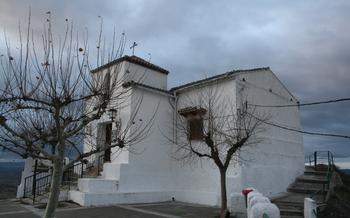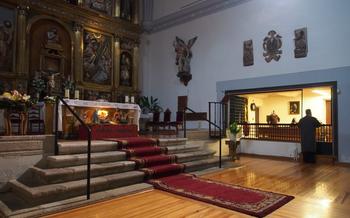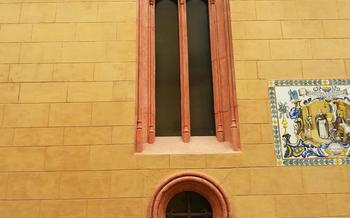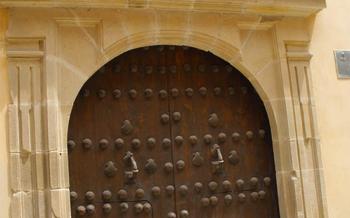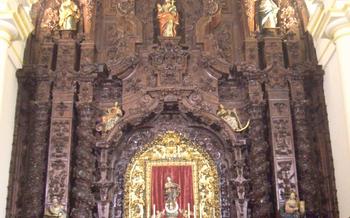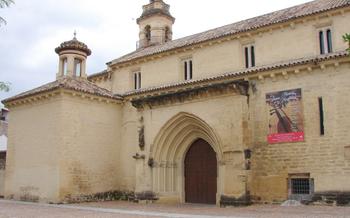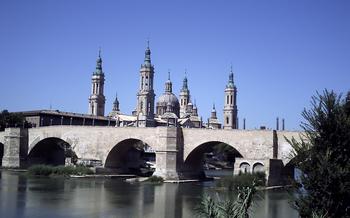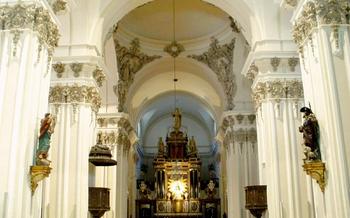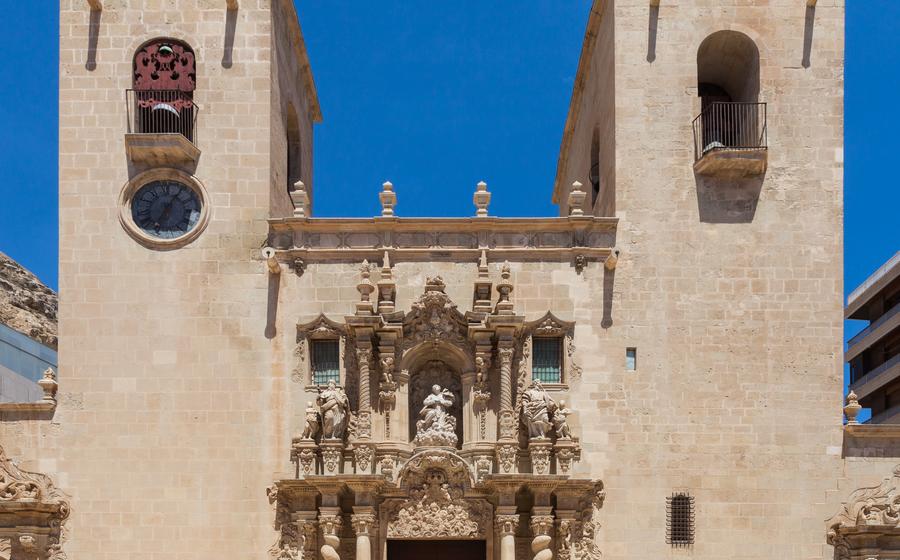
Basilica of Santa Maria
- Exploring the Facade: A Masterpiece of Gothic and Renaissance Styles
- Stepping Inside the Basilica: A Showcase of Baroque Splendor
- The Majestic Organ: A Symphony of Sacred Sounds
- Chapel of the Holy Sacrament: A Realm of Spiritual Devotion
- Chapel of the Virgin of the Nativity: A Sanctuary of Divine Grace
- The Bell Tower: A Beacon of Time and Faith
- The Cloister: A Haven of Tranquility
- The Museum of Sacred Art: A Treasury of Religious Treasures
- The Basilica as a Venue for Religious Celebrations
- The Basilica's Contribution to Alicante's Cultural Heritage
- Practical Tips for Visiting the Basilica
- Local Customs and Traditions Related to the Basilica
- Nearby Attractions and Points of Interest
- Insider Tip: Discovering Hidden Details
Exploring the Facade: A Masterpiece of Gothic and Renaissance Styles
The façade of the Basilica of Santa Maria is a testament to the fusion of Gothic and Renaissance architectural styles, creating a harmonious blend of intricate ornamentation and structural grandeur. The lower section, built in the 15th century, showcases the intricate details of the Gothic style, with pointed arches, ribbed vaults, and delicate tracery. The upper section, added in the 16th century, reflects the influence of the Renaissance, characterized by its classical symmetry, pilasters, and pediments.
The portal, the main entrance to the basilica, is a masterpiece in itself. Flanked by two slender columns topped with intricate capitals, the portal features an elaborate tympanum depicting scenes from the life of the Virgin Mary. The archivolts are adorned with intricate carvings of saints, angels, and mythical creatures, each telling a unique story.
The façade is a testament to the skill and artistry of the craftsmen who worked on it. The blend of Gothic and Renaissance styles creates a harmonious composition that is both visually stunning and historically significant. As you stand before the basilica, take a moment to admire the intricate details of the façade, each element adding to the grandeur and beauty of this architectural masterpiece.
Stepping Inside the Basilica: A Showcase of Baroque Splendor
Stepping inside the Basilica of Santa Maria is akin to stepping into a realm of awe-inspiring Baroque grandeur. The nave, with its soaring arches and intricate ribbed vaulting, creates a sense of vastness and elevation. The aisles, adorned with ornate side altars, each dedicated to a different saint or figure, invite visitors to explore the basilica's rich history and devotion.
The focal point of the interior is the magnificent Baroque altarpiece, a masterpiece of artistry and devotion. Its intricate carvings depict scenes from the life of Christ and the Virgin Mary, surrounded by a symphony of angels, cherubs, and saints. The altarpiece's grandeur is further enhanced by the interplay of light and shadow, illuminating the intricate details and creating a sense of divine presence.
Among the notable works of art within the basilica are the paintings adorning the walls and side altars. These paintings, created by renowned artists, depict religious scenes with vibrant colors and lifelike figures. Notable works include the "Adoration of the Magi" by José Vergara, the "Martyrdom of Saint Sebastian" by Juan Conchillos, and the "Immaculate Conception" by Francisco Salzillo.
The interplay of light and shadow within the basilica is a masterful orchestration that enhances the building's spiritual atmosphere. The soft glow of natural light filtering through the stained-glass windows casts a warm, ethereal hue on the interior, creating a sense of sacredness and reverence. The contrast between the illuminated spaces and the shadows lurking in the corners adds depth and drama to the basilica's interior, inviting visitors to contemplate the mysteries of faith.
The Majestic Organ: A Symphony of Sacred Sounds
Within the sacred walls of the Basilica of Santa Maria, a majestic organ stands as a testament to the harmonious blend of art, faith, and music. Constructed in the 16th century, this magnificent instrument has witnessed centuries of religious ceremonies, filling the basilica's grand interior with its soul-stirring melodies.
The organ's intricate design showcases the craftsmanship of master organ builders, featuring a multitude of pipes that produce a rich and varied range of tones. Its imposing presence commands attention, drawing the eyes upward towards the intricate carvings and gilded embellishments that adorn its façade.
Regular organ concerts and recitals are held within the basilica, inviting music lovers and worshippers alike to immerse themselves in the spiritual and emotional power of sacred music. The organ's resonant chords and ethereal harmonies create an atmosphere of awe and reverence, transporting listeners to a realm of celestial beauty.
The organ's music has played a pivotal role in shaping the religious experiences of generations of Alicante's faithful. Its solemn tones accompany the solemn rituals of Mass, while its jubilant melodies celebrate the joy of religious festivals. The organ's music serves as a bridge between the earthly and the divine, connecting the hearts and souls of worshippers with the sacred mysteries they seek to understand.
Chapel of the Holy Sacrament: A Realm of Spiritual Devotion
Nestled within the Basilica of Santa Maria, the Chapel of the Holy Sacrament exudes an aura of serenity and spiritual devotion. This sacred space is dedicated to the most profound mystery of the Catholic faith - the Holy Sacrament of the Eucharist. As visitors step into the chapel, they are enveloped in a symphony of exquisite ornamentation and intricate artistry that pays homage to this central tenet of Christianity.
The chapel's design is a testament to the reverence accorded to the Holy Sacrament. Its walls are adorned with elaborate carvings, delicate frescoes, and gleaming gold accents that create a sense of awe and wonder. The focal point of the chapel is the stunning altarpiece, a masterpiece of Baroque artistry that depicts the Last Supper, the institution of the Eucharist, and the adoration of the Blessed Sacrament.
Among the notable works of art within the chapel are the intricate carvings that adorn the tabernacle, symbolizing the sacred nature of the Eucharist. Visitors can also admire the beautiful paintings that depict scenes from the life of Christ, each one a testament to the profound faith and devotion of the chapel's creators.
The Chapel of the Holy Sacrament serves as a place of quiet reflection and prayer for the faithful. Here, they can come to contemplate the mystery of the Eucharist, to seek solace and guidance, and to deepen their connection with the divine. The chapel's serene atmosphere and exquisite ornamentation create the perfect setting for spiritual contemplation and communion with the sacred.
Chapel of the Virgin of the Nativity: A Sanctuary of Divine Grace
The Chapel of the Virgin of the Nativity holds a special place in the Basilica of Santa Maria, dedicated to the Virgin Mary, the revered mother of Jesus Christ. This chapel exudes a sense of serenity and devotion, inviting visitors to seek solace and divine grace within its sacred walls.
The interior of the chapel is adorned with intricate artwork and symbolism that pays homage to the Virgin Mary. The altarpiece, a masterpiece of craftsmanship, depicts scenes from the Virgin's life, including her nativity, presentation at the temple, and assumption into heaven. The walls are adorned with beautiful paintings and sculptures, each narrating stories of miracles and blessings attributed to the Virgin's intercession.
Devotees from all walks of life come to this chapel to offer prayers, light candles, and seek comfort and guidance. The Virgin of the Nativity is believed to be particularly compassionate and merciful, and many pilgrims have reported experiencing miraculous interventions after praying in her presence.
One of the most captivating aspects of this chapel is the collection of votive offerings that adorn its walls. These offerings, often in the form of small plaques or statues, represent the gratitude and devotion of those who have received blessings and favors through the Virgin's intercession. The collection serves as a testament to the enduring faith and love that the people of Alicante have for their beloved Virgin.
The Chapel of the Virgin of the Nativity is not just a place of worship but also a sanctuary of peace and tranquility. As visitors step into this sacred space, they are enveloped by a sense of calm and serenity, allowing them to connect with their spiritual side and find solace and comfort in the presence of the divine.
The Bell Tower: A Beacon of Time and Faith
A defining feature of the Basilica of Santa Maria is its majestic bell tower, a symbol of faith that soars above the Alicante skyline. The tower stands as a testament to the architectural prowess of the basilica's builders, showcasing a harmonious blend of Gothic and Renaissance elements. Its intricate carvings and delicate tracery are a testament to the artistic mastery of the era.
Historically, the bell tower served a crucial role in the religious life of Alicante. Its bells, with their distinctive tones, marked the hours of the day, guided sailors at sea, and summoned the faithful to prayer. The tower also played a significant role in the city's defense, acting as a watchtower to spot approaching ships or potential threats.
Today, the bell tower continues to hold a special place in the hearts of Alicante's residents. Its bells ring out melodiously, announcing religious festivals and special occasions, and their chimes have become an integral part of the city's soundscape. Visitors can climb the tower's narrow staircase to reach the top, where they are rewarded with breathtaking panoramic views of Alicante's cityscape, the Mediterranean Sea, and the surrounding mountains.
The bell tower of the Basilica of Santa Maria is not just a structural marvel but a symbol of Alicante's rich history and enduring faith. Its presence reminds us of the enduring power of tradition, the importance of community, and the timeless beauty of religious architecture.
The Cloister: A Haven of Tranquility
Step into the heart of the Basilica of Santa Maria and discover its hidden gem – the cloister. Enclosed within the basilica's walls, this tranquil oasis offers a serene escape from the bustling city. As you enter, let the silence envelop you, broken only by the gentle footsteps of fellow pilgrims and the soft rustling of leaves.
The cloister's architecture, with its graceful arches, slender columns, and ornate capitals, is a testament to the skill and artistry of medieval craftsmen. Each archway tells a story, each capital adorned with intricate carvings that depict scenes from the Bible, the lives of saints, or the history of the basilica.
Take a moment to pause and admire the beautiful interplay of light and shadow as it filters through the cloister's arches, creating a sense of peace and harmony. The cloister's serene atmosphere invites you to slow down, to reflect, and to connect with your spiritual side.
Whether you seek solace, inspiration, or simply a moment of quiet contemplation, the cloister of the Basilica of Santa Maria offers a sanctuary for the soul. As you wander through its tranquil spaces, let the beauty of the surroundings wash over you, leaving you feeling refreshed and renewed.
The Museum of Sacred Art: A Treasury of Religious Treasures
Nestled within the basilica's hallowed walls, the Museum of Sacred Art unveils a treasure trove of religious artifacts and artworks that narrate the profound history of faith and devotion in Alicante. Step into this sacred repository, and you'll be greeted by a captivating collection of paintings, sculptures, and liturgical objects that have played a pivotal role in shaping the city's rich religious heritage.
Among the museum's prized possessions are exquisite paintings that depict biblical scenes with vibrant colors and intricate details, capturing the essence of religious narratives. Gaze upon the serene faces of saints and martyrs, marvel at the dramatic depictions of miracles, and immerse yourself in the stories they convey.
Alongside these paintings, delicately carved sculptures stand as testaments to the skill and artistry of Alicante's craftsmen. From life-size statues of saints and angels to intricate bas-reliefs adorning altars and chapels, these sculptures are a testament to the deep-rooted devotion that permeates the city.
Furthermore, the museum houses a collection of liturgical objects that offer a glimpse into the rituals and ceremonies that have taken place within the basilica's walls. Intricately designed chalices, ornate monstrances, and finely crafted vestments provide a tangible connection to the sacred traditions that have been passed down through generations.
Through these precious artifacts, the Museum of Sacred Art serves as a guardian of Alicante's religious legacy. Each piece tells a story of faith, devotion, and the enduring power of spirituality, inviting visitors to delve deeper into the rich tapestry of Catholicism that has shaped the city's identity.
The Basilica as a Venue for Religious Celebrations
As the spiritual heart of Alicante, the Basilica of Santa Maria plays a central role in the city's religious calendar. Throughout the year, the basilica hosts a diverse array of religious celebrations, each steeped in tradition and fervor.
One of the most significant events is the annual Feast of the Assumption, held on August 15th. This grand celebration honors the Assumption of Mary into heaven and features a solemn procession through the streets of Alicante. The procession, adorned with flowers and candles, carries a statue of the Virgin Mary, accompanied by thousands of devout worshippers.
Holy Week, known locally as Semana Santa, is another major religious event marked with processions and solemn ceremonies. During this time, the basilica becomes a focal point for reflection and prayer, as worshippers gather to commemorate the Passion of Christ.
The basilica also hosts regular Masses and other religious services throughout the week, providing a sanctuary for spiritual contemplation and community gatherings. These services are open to all and offer visitors an opportunity to experience the basilica's sacred atmosphere and witness the deep faith of the local community.
Whether it's a grand festival, a solemn procession, or a quiet Mass, the Basilica of Santa Maria serves as a vibrant venue for religious celebrations, reflecting the deep connection between Alicante's people and their spiritual heritage.
The Basilica's Contribution to Alicante's Cultural Heritage
The Basilica of Santa Maria stands not only as a religious edifice but also as a symbol of Alicante's rich cultural heritage. Its enduring presence has played a pivotal role in preserving and promoting the city's religious traditions, serving as a source of inspiration for local artists, writers, and musicians.
Throughout the centuries, the basilica has witnessed and influenced the cultural fabric of Alicante. Its architectural grandeur has inspired countless works of art, capturing the essence of its Gothic and Renaissance elements in paintings, sketches, and sculptures. Local writers have found solace and inspiration within its sacred walls, weaving tales that intertwine history, faith, and the human spirit. Musicians have composed hymns and choral pieces that resonate with the basilica's sacred acoustics, adding to its legacy as a center of musical excellence.
Beyond its artistic influence, the basilica has been a catalyst for cultural events and celebrations that bring the community together. Religious festivals, processions, and pilgrimages centered around the basilica showcase the city's deep-rooted faith and traditions. These events, steeped in centuries of history, offer a glimpse into Alicante's vibrant cultural heritage and the enduring significance of the basilica as its spiritual heart.
As a symbol of resilience and continuity, the basilica has withstood the test of time, adapting to changing societal landscapes while maintaining its spiritual essence. It stands as a testament to Alicante's ability to preserve its cultural identity amidst modernization and globalization, showcasing the enduring power of faith and tradition in shaping the city's cultural heritage.
Practical Tips for Visiting the Basilica
To fully appreciate the Basilica of Santa Maria's grandeur, plan your visit for the late afternoon or early evening when the golden sunlight bathes the façade in a warm glow. This timing also allows you to avoid the midday crowds, ensuring a more serene and contemplative experience.
When exploring the basilica's sacred spaces, remember to dress respectfully, covering shoulders and knees. Maintain a hushed tone and be mindful of ongoing religious services or ceremonies. The basilica welcomes visitors of all faiths, but it's essential to respect the sanctity of this religious site.
For those with limited mobility, the basilica offers wheelchair accessibility through a designated entrance. Visitors can request assistance from the basilica's staff if needed.
Capture the basilica's beauty through photography, but be mindful of using flash or tripods, which may disrupt the serene atmosphere. Instead, embrace the natural light filtering through the stained-glass windows to create stunning, evocative images.
Local Customs and Traditions Related to the Basilica
The Basilica of Santa Maria is not just a religious monument but also a central part of Alicante's cultural identity. Several local customs and traditions are deeply intertwined with the basilica. During the annual festival of Santa Maria, the city comes alive with processions, music, and dancing. The basilica serves as the focal point of these celebrations, where locals pay homage to their patron saint.
One of the most unique traditions is the "miracle of the fish." According to legend, a massive fish was caught off the coast of Alicante and brought to the basilica. The fish was so large that it could not fit through the basilica's doors. In a miraculous event, the fish miraculously shrank in size, allowing it to be brought inside and blessed by the priest. This miracle is celebrated every year with a special mass and procession.
Another significant tradition is the "romeria," a pilgrimage that takes place during the summer months. Devotees from neighboring towns and villages walk for miles to reach the basilica, carrying banners and singing hymns. Upon arrival, they participate in a mass and offer prayers to the Virgin Mary. The romeria is a testament to the basilica's enduring significance as a place of pilgrimage and devotion.
The basilica also plays a role in Alicante's culinary traditions. The local dish "arroz con costra" (rice with a crust) is often prepared and shared during religious festivals. This dish is said to have originated in the basilica's kitchen and has become a beloved part of Alicante's gastronomic heritage.
The Basilica of Santa Maria stands as a symbol of Alicante's rich cultural traditions. Locals hold the basilica in high regard, and its customs and traditions continue to be passed down from generation to generation.
Nearby Attractions and Points of Interest
After exploring the Basilica of Santa Maria, visitors can easily extend their cultural journey by venturing into the surrounding area. Just a short walk away, tourists will find themselves in the heart of Alicante's historic center, where a treasure trove of attractions awaits.
For those seeking more architectural wonders, the Town Hall of Alicante, with its elegant Baroque façade, stands as a testament to the city's rich history. Within walking distance, visitors can also marvel at the Santa Barbara Castle, a medieval fortress perched atop Mount Benacantil. Its imposing walls and panoramic views have captivated generations of travelers.
To delve into Alicante's artistic heritage, the Gravina Museum of Fine Arts showcases an impressive collection of paintings and sculptures spanning various periods. Alternatively, the Alicante Museum of Contemporary Art offers a glimpse into the region's modern and avant-garde artistic expressions.
For those seeking outdoor adventures, the Postiguet Beach, with its golden sands and crystal-clear waters, provides a welcome respite from the city's hustle and bustle. Here, visitors can indulge in sunbathing, swimming, or simply strolling along the picturesque promenade.
To satisfy culinary cravings, Alicante's culinary scene offers a diverse range of options. From traditional Spanish tapas to international cuisine, visitors can savor delectable dishes at charming restaurants nestled within the city's narrow streets.
Insider Tip: Discovering Hidden Details
As you explore the basilica, keep an eye out for the intricate carvings adorning the capitals of the columns. These sculptures depict a variety of scenes from the Bible and local legends, offering a glimpse into the rich storytelling tradition of Alicante. Don't miss the hidden chapel behind the main altar, which houses a beautiful 15th-century altarpiece dedicated to the Virgin Mary. For a unique perspective, visit the basilica during a religious festival or celebration. The atmosphere is electric as the basilica fills with the sound of music, the scent of incense, and the devotion of the local community.
